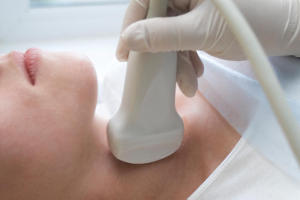Clinicians have often referred to ultrasound technology as the "stethoscope of the future," predicting that as the equipment shrinks in size, it will one day be as common at the bedside as that trusty tool around every physician's neck. According to a new report in The New England Journal of Medicine, that day has arrived.
The "Current Concepts" article by Yale School of Medicine clinicians Christopher L. Moore, M.D., and Joshua A. Copel, M.D., outlines how ultrasound use has moved beyond traditional specialties like radiology and is now being routinely employed by clinicians across myriad medical specialties and practice areas. From anesthesia to vascular surgery, Moore and Copel say, the use of ultrasonography has increased across the board, with the biggest growth seen among non-radiologists.
Over the past two decades, the equipment used in ultrasonography -- a safe, effective and non-invasive form of imaging that aids in diagnosis and guides procedures -- has become more compact, higher quality and less expensive, leading to the growth of point-of-care ultrasonography, which is performed and interpreted by the clinician at the bedside.
"Ideally, point-of-care ultrasonography can decrease medical errors, provide more real-time diagnosis, and supplement or replace more advanced imaging in appropriate situations," said Moore, assistant professor in the Department of Emergency Medicine at Yale School of Medicine. "Point-of-care ultrasonography may also allow more widespread, less expensive screening for certain illnesses."
Ultrasound imaging uses the same sonar developed for ships at sea. As sound passes through the body it produces echoes, which can identify the distance, size and shape of objects inside. During an examination, a machine called a transducer is used to view an organ and produce pictures. The transducer emits sound and detects the returning echoes when it is placed on or over the body part being studied.
"Ultrasonography quality has improved dramatically and machine sizes and prices have shrunk even more dramatically," said Copel, professor in the Department of Obstetrics, Gynecology & Reproductive Sciences at Yale. "The quality of images available now on inexpensive handheld machines is better than those of systems that cost over $100,000 15 years ago."
Some medical schools are training students to use ultrasound before they choose a specialty, according to Moore. He points out that ultrasound has been used on Mount Everest, the international space station, and in battlefield situations, an indication of its versatility as a diagnostic tool. But he cautions that indiscriminate use of ultrasonography could lead to unnecessary testing, unnecessary interventions in the case of false positive findings, or inadequate investigation of false negative findings.
"More imaging could simply lead to increased expense without added benefit, or might even be harmful without appropriate training and quality assurance," said Moore. "As this technology grows, we need a better understanding of when and how it can be used effectively and competently."

Ultrasound use has moved beyond traditional specialties like radiology
and is now being routinely employed by clinicians across myriad medical specialties and practice areas,
according to a new report by Yale School of Medicine clinicians. (Credit: iStockphoto)
From:http://www.sciencedaily.com/releases/2011/02/110223171247.htm